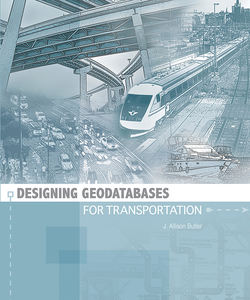Designing Geodatabases for Transportation

Реклама. ООО «ЛитРес», ИНН: 7719571260.
Оглавление
J. Allison Butler. Designing Geodatabases for Transportation
Contents
Foreword
Preface
Acknowledgments
About the author
Introduction
Transport databases
Data models
Agile methods
Building the agile geodatabase
Book organization
Notes
Data modeling
Data types
Files
Tables
Relationships in relational databases
Object-relational databases
Relationships in object-relational databases
The data-modeling process
Conceptual data models
Logical data models
Physical data models
Notes
Geodatabases
The geodatabase
The geodatabase framework
The data dictionary view
Geodatabase field types
Attribute domains
Valid value tables
Subtypes
Relationship classes
Origin and destination tables
Other geodatabase classes for transportation data models
Normalization
Tracking events
Geodatabase performance
Notes
Best practices in transportation geodatabase design
Centerlines
Intersections
Realignment
Segmentation methods
Mapping applications
Census files
Accommodating multiple street names
Putting the segments together
Emergency dispatch
Designing a pavement management system
Geometric networks
Travel demand models
Building the travel demand model
Map geodatabase for pathfinding
Data editing
Traditional editing process
Multiple editors
Continuous versioning
Preserving data dictionary history
Separating the editing and published geodatabases
Service-oriented architecture
Linear referencing methods
The problem with large transportation datasets
The advent of linear referencing systems
Dynamic segmentation
Making routes
Traversals
Advanced dynamic segmentation functions
Offset events
Other dynseg options
Going beyond dynseg
Adding element tables
Intersections
Accommodating multiple LRMs
Creating traversals for pathfinding
Traffic monitoring systems
Traffic monitoring sites
Traffic monitoring system
The data model
TMS event tables
Seasonal factor groups
Equipment inventory
Traffic monitoring site maintenance
Traffic counts
Classic transportation data models
The ArcInfo route system
Linear datums
Providing a linear datum in ArcGIS
NCHRP 20-27(2)
FGDC data exchange standard
The GDF format
NCHRP 20-27(3)
Other transportation data models
Notes
The original UNETRANS data model
Network features
Routes and location referencing
Other key structures in the UNETRANS model
Improving the UNETRANS data model
Editing support
Describing LRM positions
Aspects and elements
Mode-specific Inventory Package classes
Modal class groups
Association relationships
Intersections
Bridges
Events
Pavement management example
Mobile Objects
Using all three packages
The revised UNETRANS network data model
Network connectivity
Network attributes
Building a network dataset
Turns
Alternative methods to accommodate bridges
Bells and whistles
The transit data model
Notes
State DOT highway inventory: Editing
Refining the conceptual data model
Route segmentation
Dealing with route realignment
Handling divided roads
Route type issues
Events for everyone
Complex elements
Centerlines
A special calibration problem
Migrating to the new structure
Conclusion
State DOT highway inventory: Publishing
Certifying the Edit Geodatabase
Publishing centerline features for dynseg
Creating event tables
Publishing traversals
Getting started with SQL
Using relational joins
Proceed with caution
Conclusion
A multipurpose transit geodatabase
The central problem
Expanding the network model
The big picture
Walk segments
Fares
Vehicles
Navigable waterways
What’s it for?
Constructing waterway features
River-reach data
Where am I?
Employing the new UNETRANS model
Waterway events
Channel geometry
Gauging stations
Bridges
Notes
Railroads
Tracks
Railroad intersections
Track geometry
Railroad companies
Yards and interchanges
Trackside structures
Railroad grade crossings
Intermodal facilities
Final thoughts
Index
Отрывок из книги
Designing Geodatabases for Transportation is an outstanding contribution to the ESRI thematic geodatabase design series of “best practices.” This transportation domain data model achieves the two primary goals of the series:
• Provide best-practice templates for implementing geodatabases for transportation applications.
.....
Here is where you should expect your first philosophical debate. You’ll find such common entities as Road, Railroad Track, Bridge, and Airport will often have very different meanings throughout the agency. What do we mean by Route? Is it the continuous piece of pavement that winds through many states, each one assigning its own name to it? Or does the name itself define the extent of a route? If the latter, what happens when the name is changed or the route takes a different path due to construction? How about if the road is realigned in some way so that the length changes? Does Road include Right of Way as an element, or is Road an element of Right of Way? Is Airport a piece of land, a terminal, a collection of runways, or an airspace? Is Railroad Track one set of rails, with a section of double-tracked mainline being two Railroad Track members, or is Railroad Track like Road, where each track is equivalent to a lane of traffic and the number of tracks is an attribute? Is a Bridge across an interstate highway part of the interstate or the road that crosses the Interstate? Answering such questions is intense, emotional, and necessary. You will quickly discover that the most important relationships are those in the room, not those shown in the data model.
A conceptual data model shows entities and their relationships. It does not include attributes. A conceptual data model expresses central concepts, illustrates data structures, and describes components of the ArcGIS object model. You will use conceptual data models to translate user requirements into data structures. Creating the data model usually begins the process of developing the application ontology, which includes formal definitions for all the entities, attributes, and operations that will be part of the final design.
.....